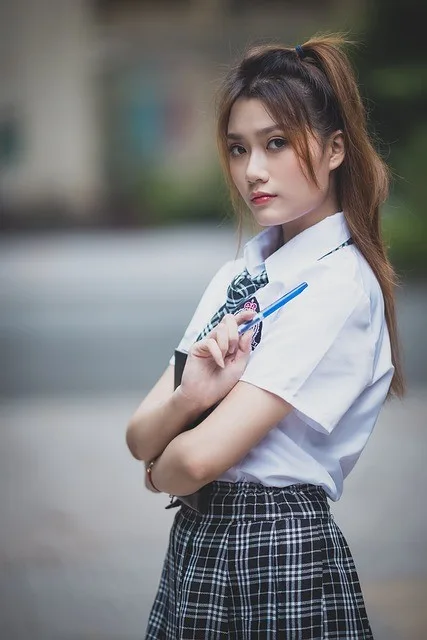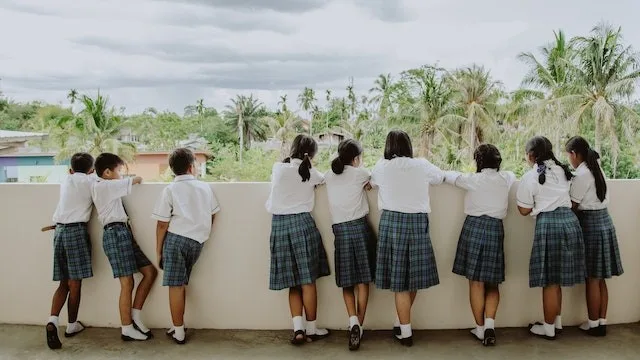Table of Contents
Introduction
Taylor Martin once said, “In uniform, we not only show our discipline but also our respect for something greater than ourselves.”
Taylor Martin is a prominent Australian politician. Since 3 May 2017, has been a member of the New South Wales Legislative Council as a Liberal.
Primary school uniforms: They’re more than just clothing; they’re a canvas of tradition, identity, and style. Join me on a journey that explores how these seemingly ordinary garments bridge the gap between tradition and modernity, offering students a unique space for self-expression.
I am Mohammed Ibrahim Anwar have been in the textile and apparel industry since 1997. I have expanded my knowledge and experience since then. A detailed introduction can be found on my About Us page.
Discover the art of balancing style and uniformity, understand the significance of fabric choices, and delve into captivating stories from around the globe. Hope this read adds value to your decision making.
The Art of Balancing Style and Uniformity
In a world where fashion trends seem to change by the minute, primary school uniform stand as a timeless symbol of identity and unity. The art of balancing style and uniformity in these school outfits has never been more relevant. In this section, we will explore why primary school uniform matter in today’s fashionable world and how they find harmony where style meets school regulations.
Why Primary School Uniform Matter in Today’s Fashionable World
Primary school uniform can alleviate the pressure of dressing up for school, making mornings less stressful for both children and parents. This simplicity can also help students focus on their studies rather than their outfits.
In today’s fashionable world, primary school uniform serve as a counterbalance to the ever-changing trends. While they adhere to certain standards, they also provide an avenue for personal expression, often through accessories or grooming choices. In this way, students can subtly showcase their personalities while maintaining uniformity.
In sum, primary school uniform matter because they create a sense of community, instill important values, reduce stress, and offer a unique blend of tradition and individuality in today’s fashion-conscious society.
Finding Harmony: Where Style Meets School Regulations
Primary school uniform are a delicate balance between adhering to school regulations and allowing students a degree of personal style. Finding this harmony is crucial to ensuring that uniforms serve their intended purpose without stifling creativity or comfort.
One way this harmony is achieved is through the selection of uniform pieces. Many schools offer a range of options within their dress code, allowing students to choose from various styles of shirts, pants, skirts, or dresses. This flexibility not only accommodates different body types and preferences but also encourages a sense of ownership over one’s attire.
Accessories also play a pivotal role in personalizing uniforms while maintaining uniformity. Students often use ties, scarves, belts, and even footwear to add a touch of individuality to their outfits. These small details can go a long way in making students feel comfortable and confident in their uniforms.
Exploring Primary School Uniform Attire for Boys and Girls
Primary school uniform are a canvas upon which students express themselves. In this section, we will take a closer look at the smart and stylish options available for boys’ primary school uniform, as well as the chic and comfortable choices for girls. From classic designs to modern adaptations, discover how these uniforms play a crucial role in shaping students’ identities.

Smart and Stylish: Boys’ Primary School Uniform
Boys’ primary school uniform have come a long way from the basic shirts and pants of the past. Today, these uniforms are designed to be not only functional but also smart and stylish, catering to the comfort and confidence of young scholars.
- Classic Styles with a Modern Twist: Traditional uniforms for boys often include collared shirts and dress pants. However, modern variations of these classics incorporate comfortable fabrics and updated fits to ensure that boys feel at ease throughout the school day.
- Color Choices: While the traditional color palette for boys’ uniforms often consists of navy, black, and khaki, many schools now offer a wider range of color options, allowing boys to express their preferences and individuality.
- Accessories for Personalization: Accessories such as ties, belts, and blazers provide opportunities for personalization. Boys can choose from various tie patterns and colors to add a touch of uniqueness to their uniform.
- Footwear Selection: The choice of shoes can also impact a boy’s overall look. From classic loafers to sporty sneakers, there are options that both adhere to school regulations and align with personal style.
- Seasonal Adaptations: Boys’ uniforms often adapt to different seasons. Schools may provide options like short-sleeved shirts for warm weather and sweaters or vests for colder months, ensuring year-round comfort.
- Functional Features: Many modern boys’ uniforms are designed with functional features in mind, such as reinforced knees for durability and stain-resistant fabrics to withstand the rigors of daily wear.
In summary, boys’ primary school uniform have evolved to strike a balance between tradition and contemporary style. They offer a range of choices that allow boys to feel comfortable and confident in their attire while adhering to school regulations.

Chic and Comfortable: Girls’ Primary School Uniform
Girls’ primary school uniform have undergone a transformation, moving beyond the conventional and embracing chic and comfortable designs that empower young scholars.
- Diverse Dress Options: While dresses were once the primary choice for girls’ uniforms, today’s options include skirts, jumpers, and pants, providing girls with a variety of choices that cater to their preferences.
- Stylish Blouses and Shirts: Girls’ uniform blouses and shirts now come in various styles and fits, ensuring both comfort and a sense of personal style. These tops may feature rounded collars, peter pan collars, or even tie-neck details.
- Color Palettes: Just like boys’ uniforms, girls’ uniforms now often include a wider range of color choices, allowing for individual expression. Schools may offer options beyond the traditional navy and khaki, including pastels and bright hues.
- Accessories and Embellishments: Girls can personalize their uniforms through accessories like hair bows, ribbons, and headbands. Some schools even allow embroidered monograms or logos to add a unique touch.
- Footwear Variety: Girls’ uniforms pair well with different types of footwear, from classic Mary Janes to comfortable flats or sneakers. These options give girls the freedom to select what suits their style and comfort.
- Functional and Fashionable: Many girls’ uniforms now prioritize functionality, with features like adjustable waistbands for growing children and fabrics that are both durable and soft to the touch.
In conclusion, girls’ primary school uniforms have evolved to blend chic and comfort. These modern uniforms empower girls to embrace their individuality while adhering to school dress codes, ensuring they feel confident and stylish in their attire.
Fabric Matters: Understanding Materials in Primary School Uniform
Behind every primary school uniform is a carefully selected fabric that determines comfort, durability, and appearance. This section will unravel the fabric choices for primary school uniforms, focusing on what goes into boys’ school uniforms and the various fabrics that makeup girls’ school uniforms. Understanding these materials is key to making informed choices when it comes to outfitting our young scholars.
The Fabric of Choice: What Goes into Boys’ Primary School Uniform
Boys’ Primary school uniform are designed with both comfort and durability in mind, and the choice of fabric plays a crucial role in achieving these goals. Understanding the materials used in boys’ school uniforms can help school admistration make informed decisions when selecting attire for their young scholars.
- Cotton: Cotton is a popular choice for boys’ school uniforms due to its breathability and comfort, especially in warmer climates. It’s soft against the skin and allows for good air circulation, helping students stay cool during the school day.
- Polyester: Polyester is known for its durability and resistance to wrinkles and stains. Many modern boys’ uniforms incorporate polyester blends to ensure longevity and ease of care. This fabric is particularly favored for pants and blazers.
- Wool: Wool is often used in boys’ blazers, vests, and sweaters, especially in colder regions. It provides warmth without adding excessive weight, making it ideal for winter uniforms.
- Blended Fabrics: Some boys’ uniforms feature fabric blends that combine the advantages of different materials. For instance, a cotton-polyester blend might offer the comfort of cotton with the durability of polyester.
- Twill and Gabardine: These are popular fabric weaves for boys’ dress pants and shorts. Twill and gabardine fabrics are known for their strength and resistance to wrinkles, making them ideal for maintaining a polished look throughout the school day.
- Performance Fabrics: In recent years, there has been a trend toward using performance fabrics in boys’ uniforms. These fabrics often have moisture-wicking properties to keep students dry and comfortable, especially during physical activities.
Understanding the fabric choices in boys’ school uniforms can help parents select uniforms that align with their children’s needs and the local climate, ensuring that boys are comfortable and well-prepared for their school day.
From Cotton to Polyester: The Fabrics Behind Girls’ School Uniforms
Girls’ school uniforms are crafted with careful consideration of both comfort and style. The fabrics chosen for girls’ uniforms are essential in achieving these objectives. Let’s explore the common materials used in girls’ school uniforms.
- Cotton: Cotton is a versatile and breathable fabric often used in girls’ uniform blouses, skirts, and dresses. It provides comfort and is suitable for warmer weather.
- Polyester: Polyester is known for its durability and resistance to wrinkles and stains, making it a popular choice for girls’ uniform pants, skirts, and blazers. It retains its shape well and is easy to care for.
- Blended Fabrics: Many girls’ uniforms feature fabric blends that combine the benefits of different materials. For example, a cotton-polyester blend may offer the comfort of cotton with the durability of polyester.
- Wool: Wool is often used in girls’ uniform blazers, cardigans, and skirts for colder seasons. It provides warmth without sacrificing style and is commonly found in winter uniforms.
- Knit Fabrics: Girls’ uniform sweaters and cardigans are often made from knit fabrics, which offer a balance of comfort and elegance. These fabrics are soft to the touch and provide warmth during cooler months.
- Performance Fabrics: Some girls’ uniforms incorporate performance fabrics that offer moisture-wicking properties. These fabrics help girls stay comfortable and dry during physical activities or in warm weather.
Understanding the materials used in girls’ school uniforms can assist school committees in selecting uniforms that suit their students’ needs and the local climate. Whether it is the softness of cotton or the durability of polyester, these fabric choices are designed to ensure girls feel comfortable and confident in their school attire.
Beyond the Basics: Personalizing Primary School Uniform
While uniforms may provide a common ground, students often seek ways to stand out and express their individuality. In this section, we will explore how students can add flair to their uniforms through creative accessories and customization. Discover the innovative ways young scholars are expressing their uniqueness while adhering to uniform constraints.
Adding Flair to Uniforms: Creative Accessories and Customization
Personalizing primary school uniforms is more than just adhering to a dress code; it’s an opportunity for students to express their individuality and creativity. Here, we delve into how young scholars can add flair to their uniforms through creative accessories and customization.
- Unique Accessories: One of the simplest ways to personalize uniforms is through accessories. Students can choose from a variety of ties, bowties, scarves, and belts that match their style. These small additions can make a significant difference in the overall look.
- Embroidery and Monograms: Many schools allow students to have their names or initials embroidered on uniform items like blazers, sweaters, or backpacks. This not only adds a personal touch but also helps prevent uniform mix-ups.
- Colorful Socks and Tights: While the uniform may dictate the clothing’s primary colors, students often have the freedom to select their socks or tights. This pop of color can reflect their personality and style.
- Creative Hairstyles: For students with longer hair, hairstyles can be a form of personal expression. From braids to ponytails, how students choose to wear their hair can be an extension of their identity.
- Custom Buttons and Pins: Some schools permit the use of custom buttons or pins on blazers or cardigans. These can showcase a student’s hobbies, interests, or achievements.
- DIY Accessories: Encouraging creativity, some students opt to create their accessories. This can include making unique hair accessories, personalized jewelry, or even hand-painted sneakers.
- Outerwear Choices: While not part of the official uniform, outerwear such as jackets or coats provides another avenue for personalization. Students can choose outerwear that reflects their style while staying warm during the colder months.
Personalizing uniforms not only allows students to feel more comfortable in their attire but also fosters a sense of ownership and pride in their school identity. It’s a creative outlet that shows that even within uniform constraints, individuality can shine.
Expressing Individuality Within Uniform Constraints
Primary school uniform often come with specific guidelines, but that doesn’t mean students can’t express their individuality. In this section, we explore how young scholars can embrace their uniqueness while adhering to uniform constraints.
- Choosing the Right Fit: Even within uniform constraints, students can choose clothing that fits them well and complements their body type. This ensures comfort and confidence throughout the school day.
- Embracing Grooming: Grooming choices can be a form of self-expression. Students can experiment with different hairstyles, provided they adhere to school grooming policies.
- Focus on Accessories: Accessories are a subtle yet powerful way to express individuality. Items like watches, bracelets, or even unique backpacks can showcase a student’s personality.
- Personal Values and Interests: Some students express their individuality through their actions. Involvement in extracurricular activities, clubs, or community service can showcase personal values and interests.
- Creative Use of Colors: While uniform colors may be standard, students can creatively combine and layer uniform pieces to create unique looks. For example, mixing and matching blouses, ties, or vests can add flair.
- Positive Attitude and Kindness: Being kind, respectful, and displaying a positive attitude can set a student apart. These qualities not only reflect individuality but also contribute positively to the school community.
- Celebrating Achievements: Awards, badges, or pins earned through academic or extracurricular achievements can be displayed with pride on the uniform, demonstrating a student’s dedication and accomplishments.
Expressing individuality within uniform constraints is about finding a balance between conformity and personal identity. It teaches young scholars valuable lessons about self-expression, respect for rules, and the importance of embracing their uniqueness within a structured environment.

Primary School Uniform Around the Globe: A Cultural Exploration
School uniforms not only shape the identity of students but also reflect the unique cultures and traditions of nations around the world. In this section, we embark on a fascinating journey exploring primary school attire globally. From kilts in Scotland to kimonos in Japan, we’ll delve into the rich tapestry of school uniform traditions and stories from different countries.
From Kilts to Kimonos: Unique School Attire Worldwide
School uniforms serve as cultural ambassadors, reflecting the traditions, values, and identities of nations around the world. In this section, we embark on a journey to explore the fascinating diversity of school attire, from kilts in Scotland to kimonos in Japan.
- Scotland – Kilts and Tartan: Scotland is renowned for its distinctive school uniforms, often featuring kilts and tartan patterns. The kilt, a symbol of Scottish heritage, is a common choice for boys, while girls may wear skirts or pinafores in similar tartan designs.
- United Kingdom – Blazers and Ties: The United Kingdom, including England and Wales, often opts for smart blazers and ties as part of school uniforms. These classic ensembles emphasize a sense of tradition and formality.
- Japan – Kimonos and Gakurans: Japanese school uniforms are a fusion of modernity and tradition. Boys often wear gakurans, which include black jackets and trousers, while girls may don traditional kimono-inspired outfits or sailor-style uniforms.
- South Korea – Preppy Styles: South Korean school uniforms often feature preppy and fashionable designs. Girls might wear pleated skirts and blazers, while boys sport fitted trousers and ties. These uniforms have become iconic in K-dramas and K-pop culture.
- India – Diversity of Styles: India showcases a wide range of school uniform styles due to its diverse culture. Uniforms can vary from traditional kurta-pajamas to Western-style blouses and skirts, reflecting regional and cultural influences.
- Australia – Hats and Summer Dresses: Australian school uniforms often include wide-brimmed hats to protect students from the sun. Summer dresses for girls and shorts or trousers for boys are common choices, adapted to the country’s climate.
- Africa – Vibrant Colors: In many African countries, school uniforms feature vibrant colors and unique designs. These uniforms celebrate the rich cultural heritage of the continent and often include bold patterns and accessories.
- Russia – Classic Styles: Russian school uniforms maintain a classic and formal appearance, typically consisting of dark-colored blazers and trousers for boys and dresses or skirts for girls.
- China – Mao Suits and Qipaos: Chinese school uniforms can vary by region but often incorporate elements of traditional Chinese clothing. Boys may wear Mao suits, while girls might opt for qipaos or modern variations.
- Brazil – White Shirts and Shorts: Brazilian school uniforms often feature white shirts paired with shorts or skirts, reflecting the country’s warm climate and Portuguese influence.
These examples provide just a glimpse into the rich tapestry of Primary School Uniform worldwide. Each uniform carries its unique cultural significance, emphasizing the importance of tradition, identity, and community in the global education landscape.
Uniform Traditions: Stories from Different Countries
School uniforms are not just clothing; they are a reflection of a nation’s culture, history, and educational values. In this section, we delve into the unique traditions and stories behind school uniforms in various countries around the world.
- France – The Influence of History: French school uniforms, known as “l’uniforme scolaire,” have evolved over time. Their traditional navy blue smocks (blouses) were inspired by the uniforms of the French Revolution. Today, the uniform represents a commitment to equality in education.
- Germany – A Mark of Discipline: German school uniforms, particularly in the eastern part of the country, have often been associated with discipline and unity. Many students wear uniforms that include white shirts and dark pants or skirts.
- China – Red Scarves and Youth: In China, students often wear red scarves as part of their school uniforms. These scarves are symbolic of the Communist Youth League and signify the role of young students in building a socialist society.
- Italy – Regional Variations: Italy has a diverse range of school uniforms influenced by regional traditions. In some regions, students wear black smocks, while in others, they don aprons or blazers in different colors, reflecting the nation’s rich cultural diversity.
- Singapore – Promoting Unity: Singaporean school uniforms emphasize unity and discipline. The white shirt and dark pants or skirts, often paired with a school badge, symbolize the nation’s commitment to education and excellence.
- Nigeria – Colorful Expressions: Nigerian school uniforms are known for their vibrant colors and unique styles. They reflect the country’s rich cultural heritage and emphasize the importance of education in Nigerian society.
- Canada – The Influence of Climate: Canadian school uniforms vary based on the climate and region. In colder areas, students wear warm jackets and pants, while in milder climates, uniforms may include polo shirts and khakis.
- Greece – The Influence of Ancient Culture: Greek school uniforms often incorporate elements inspired by the nation’s ancient culture. Girls may wear dresses reminiscent of Greek mythology, and boys don blazers and ties, combining tradition with modernity.
- Peru – Indigenous Influences: In Peru, school uniforms often incorporate indigenous designs and colors. These uniforms celebrate the country’s diverse indigenous cultures and promote cultural identity.
- Pakistan – A Blend of Tradition and Modernity: Pakistani school uniforms often blend traditional clothing styles with modern elements. Students may wear shalwar kameez or trousers and shirts, depending on the school’s dress code.
These stories from different countries highlight the significance of school uniforms in preserving cultural identity, fostering unity, and emphasizing the importance of education on a global scale. Each uniform tradition carries a unique narrative that contributes to the global tapestry of education.
Conclusion:
In our exploration of primary school uniform, we’ve unveiled a world of tradition, style, and individuality. From the art of balancing style and uniformity to understanding the fabrics that shape these outfits, we’ve seen how primary school uniform matter in today’s fashionable world. We’ve discovered how students personalize their attire, adding flair and expressing their uniqueness while staying within uniform constraints. Finally, our journey has taken us across the globe, where we’ve explored the rich cultural tapestry of school uniform traditions from kilts in Scotland to kimonos in Japan and beyond.
As parents, educators, and students, we play a role in shaping the narrative of primary school uniform. Whether it’s choosing the right fit, exploring creative accessories, or understanding the cultural significance of uniforms, we can all contribute to making the school uniform experience a positive and empowering one. If you have a project on delivering smart quality uniforms do let us have your requirements by mail: [email protected] and we will take this forward.
FAQ
What is regular school uniform?
A regular school uniform is a standardized outfit worn by students attending a particular school. It typically consists of specific clothing items such as shirts, pants, skirts, dresses, and may include accessories like ties or scarves. The purpose is to promote a sense of equality, discipline, and school identity among students.
What is the best Colour for a school uniform?
The best color for a school uniform often depends on the school’s traditions and climate. Neutral colors like navy blue, black, white, and khaki are common choices as they are versatile, timeless, and suitable for various weather conditions. The best color should align with the school’s dress code and climate considerations.
How do I choose a school uniform?
Choosing a school uniform involves considering the school’s dress code, climate, and your child’s comfort and preferences. Start by reviewing the school’s guidelines, then select clothing items made from comfortable and durable fabrics. Involve your child in the decision-making process to ensure they feel confident and comfortable in their uniform. Additionally, consider any customization options allowed by the school to add a personal touch.



Pingback: Unique Clothing Identity For School Uniform For Girls & Boys
Pingback: Stand Out With Style: Embrace Diversity Of Types Of Uniforms